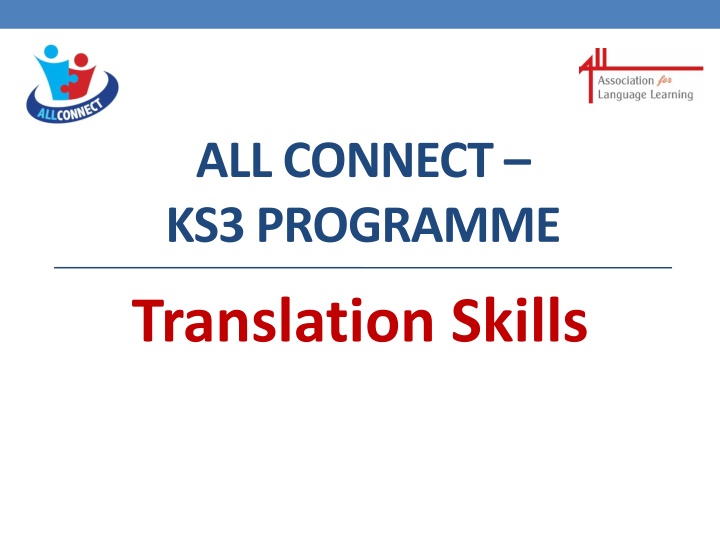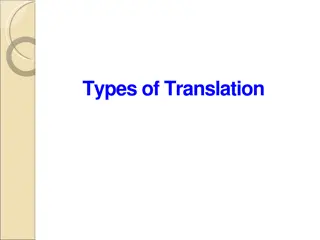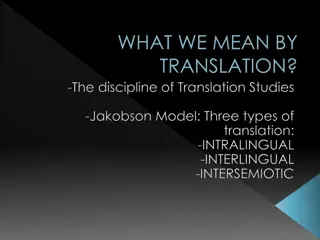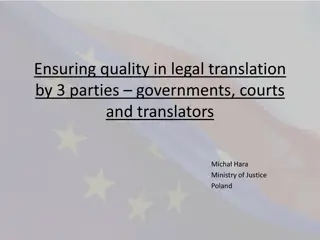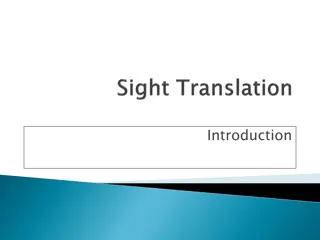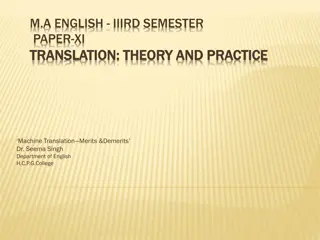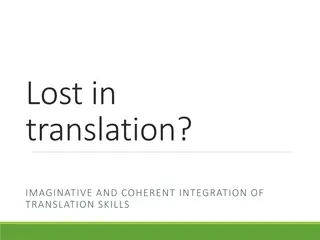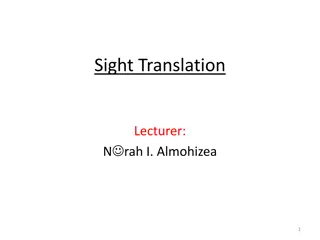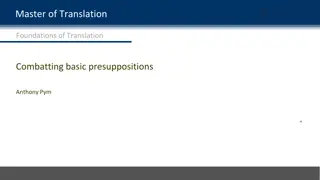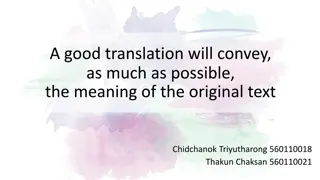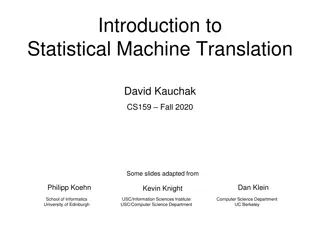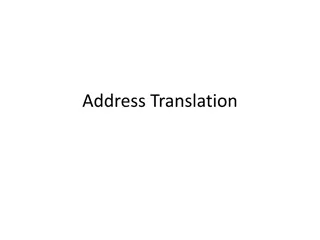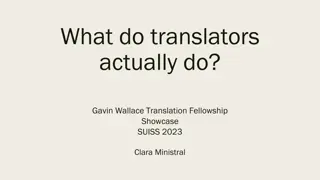Enhancing Translation Skills in Key Stage 3 Language Learning
Explore the fundamentals of translation in language education for Key Stage 3 students. Learn the importance of translation, practical strategies, and curriculum alignment. Set objectives to develop student translation skills effectively through interactive practices and comprehensive planning.
Download Presentation

Please find below an Image/Link to download the presentation.
The content on the website is provided AS IS for your information and personal use only. It may not be sold, licensed, or shared on other websites without obtaining consent from the author.If you encounter any issues during the download, it is possible that the publisher has removed the file from their server.
You are allowed to download the files provided on this website for personal or commercial use, subject to the condition that they are used lawfully. All files are the property of their respective owners.
The content on the website is provided AS IS for your information and personal use only. It may not be sold, licensed, or shared on other websites without obtaining consent from the author.
E N D
Presentation Transcript
ALL CONNECT KS3 PROGRAMME Translation Skills
Aims of the translation module To discuss the rationale for including translation in language lessons in Key Stage 3 To explore interactive practice for purposeful translation into and out of the foreign language To plan accordingly for skills development, piloting and integrating skills, strategies and activities into schemes of work
Objectives of this session explore and reflect on curriculum requirements discuss the relevance of translation in the MFL classroom evaluate suggested strategies to develop translation skills devise own strategies for classroom practice consider progression through KS3 and into KS4/KS5 raise questions and share professional thinking inform an individual Action Plan leading into the follow-up sessions
Starter: What is Translation? Meet your neighbours to discuss What do we mean by the word translation ? What are the two different types of translation? How might students already be translating in your classroom(s)? What and when are they translating? For what purpose?
Outline for this session KS3 and KS4 Curriculum with reference to translation Why translate? What types of translations are students already doing? What types of translation could they be doing? Planning for the classroom: oSupport oMaking a start oPiloting Action plan
Curriculum Purpose of study The teaching should enable pupils to express their ideas and thoughts in another language and to understand and respond to its speakers, both in speech and in writing. It should also provide opportunities for them to communicate for practical purposes
Aims The national curriculum for languages aims to ensure that all pupils: understand and respond to spoken and written language from a variety of authentic sources speak with increasing confidence, fluency and spontaneity, finding ways of communicating what they want to say, including through discussion and asking questions, and continually improving the accuracy of their pronunciation and intonation can write at varying length, for different purposes and audiences, using the variety of grammatical structures that they have learnt discover and develop an appreciation of a range of writing in the language studied
Linguistic competence listen to a variety of forms of spoken language to obtain information and respond appropriately express and develop ideas clearly and with increasing accuracy, both orally and in writing read and show comprehension of original and adapted materials from a range of different sources, understanding the purpose, important ideas and details, and provide an accurate English translation of short, suitable material read literary texts in the language [such as stories, songs, poems and letters], to stimulate ideas, develop creative expression and expand understanding of the language and culture
Linguistic competence write prose using an increasingly wide range of grammar and vocabulary, write creatively to express their own ideas and opinions, and translate short written text accurately into the foreign language.
Previously What the Programme of Study says at Key Stage 2: Listening explore the patterns and sounds of language through songs and rhymes and link the spelling, sound and meaning of words Reading broaden their vocabulary and develop their ability to understand new words that are introduced into familiar written material, including through using a dictionary Grammar understand basic grammar appropriate to the language being studied, such as (where relevant): feminine, masculine and neuter forms and the conjugation of high-frequency verbs; key features and patterns of the language; how to apply these, for instance, to build sentences; and how these differ from or are similar to English.
And furthermore! GCSE criteria suggest students will have to: translate a short passage from the assessed language into English translate sentences and short texts from English into the assessed language to convey key messages accurately and to apply grammatical knowledge of language and structures in context
And even more! Draft A level criteria suggest students will have to: summarise information from spoken and written sources, report key points and subject matter in speech and writing translate an unseen passage or passages from the language of study into English at AS and A level translate unseen sentences or short texts at AS, and an unseen passage or passages at A level, from English into the language of study
What is our rationale? Pragmatic: oCurriculum requirement oExam specification oReal-world usefulness oAlready built into our practice Professional oDevelops higher order thinking skills oMotivating for learners oApplication of grammatical structures learnt What do you think?
How do language teachers and learners already develop translation skills? Taking translation to mean a rendering of something into another language or in to one's own language from another ... work with a partner to note down some simple activity types for Key Stage 3 for (1)translation into the target language and (2) translation into English (make two columns / groups) Are there any activities which could be used for both?
Translation activities Into the Target Language Into English Vocabulary test Oral dominoes (words or phrases) Written dominoes (words or phrases) Gap-fill (missing word) Translate simple sentences (grammar checkpoint) Find the English phrases in the Target Language text Parallel texts (reading and creation of) Redraft someone else s translation Add titles (in English) to text in Target Language Paraphrase or summarise General questions on a text what s the slogan? , where might you see this sign? - Question and answer in English (initial reaction) - True / false or multiple choice - Subtitles for a TV programme or advert
Translation into English Uses and develops reading and understanding strategies Provides a way of demonstrating understanding of texts Provides an opportunity for pupils to respond in their own language to a text they have read Provides an opportunity for pupils to develop greater intercultural awareness and understanding Provides an opportunity for pupils to develop an awareness of language and how it is structured or used
Into English Year 7 School topic Canteen vocabulary How could you use this / adapt this? Students watched a short video about the canteen in a French school and then answered the questions in English. 1) What s on the menu today? 2) What can you choose? 3) What does Louis think of the canteen?
Into English Year 8 Clothes and fashion Sense or nonsense How could you use this / adapt this? Students read opinion phrases about clothes and decided if the sentences made sense. 1) Je porte un pull orange, parce que je d teste la couleur. 2) J adore mon jean bleu, car j ai un style d contract . 3) Je n aime pas les robes, parce que je pr f re les jogging.
Into English Year 9 Jobs with languages Translating sentences How could you use this / adapt this? In order to practice the use of on with modal verbs in the present tense, students translated the sentences into English. (examples were given) 1. Si on veut travailler 2. On peut rencontrer 3. On doit aimer 4. On doit respecter
Going further These activities support the development of translation into English and strengthen comprehension skills, but to develop translation skills more robustly involves dealing with more challenging text, with some unknown vocabulary so that students decoding and inference skills, as well as grammar knowledge are put to work. This is an explicit part of the new PoS but will also be tested at KS4. Over to you: Using the text on the next slide, generate a series of activities using ideas from the list created earlier in the session. The aim is to lead up to a short translation task, building up gradually.
Over to you: Une fen tre est ouverte, le chat saute sur le rebord. Zo , une petite fille de sept ans, est confortablement install e sur son lit, un livre ouvert sur les genoux. Le chat saute dans la chambre pour la rejoindre, puis d pose avec d licatesse le l zard sur les pages du livre. La fillette fait une caresse a son ami. Elle examine ensuite le l zard pour en admirer toutes les couleurs. Son devoir accompli, le matou va se d salt rer dans sa gamelle remplie de lait. On peut lire dessus le nom Dino , car dans cette maison, le chat a un nom. Une vie de chat , Alain Gagnol, Jean-Loup Felicioli
Translation into the Target Language Tests understanding of words Requires an ability to apply understanding of grammatical structures learnt Provides an opportunity for pupils to reflect on the similarities and differences between the two languages in terms of vocabulary and structure Develops writing skills in the target language Enables students to write more creatively and accurately in the target language
Gap-fill into the Target Language Year 7 School topic Practising times How could you use this / adapt this? Students had to write the times out in French to complete the sentences. This followed a lesson where we learnt the time. 1. Le lundi, .............., j ai maths 2. Le mardi, .............., j ai anglais 3. Tous les jours, .............., j ai la r cr ation (Mid-day) 4. Le mercredi, .............., j ai histoire-g o (Three o clock) (Ten to nine) (Ten past two)
Find the phrases in the text Year 8 Free-time Longer reading text on clothes How could you use this / adapt this? J adore la mode et je porte toujours des v tements de marque . Le weekend dernier, j ai port mon jean et ma nouvelle chemise verte pour aller a une f te. C tait g nial. Le weekend prochain je vais porter une robe pour le mariage de ma s ur. Je n aime pas ma robe bleue alors je vais acheter une belle robe noire! Students read the text and then looked for the phrases, which they highlighted on their copy of the text. I love fashion Last weekend I wore my jeans It was great Next weekend I m going to wear a dress 1. 2. 3. 4.
Translating short sentences (grammar) Year 9 Future plans Focus on future tense How could you use this / adapt this? Students completed the translation as a checkpoint to ensure they understood how to use the simple future with je . 1. I will work hard at school. 2. I will do all my homework. 3. I will get fit. 4. I will find a part-time job.
How can pupils translate? Does translation always have to be written? How else could we translate? Listening, Speaking, Reading and Writing how might we translate in the four different skills? Which activities must be done individually? Which could be done in pairs or small groups? Why might it be beneficial to work in pairs or small groups? How could we translate in pairs? What strategies or activities could we use? How could we translate in groups? What strategies or activities could we use?
Over to you: Using the ideas generated earlier in the session, create a short task translating from English into the Target Language for a lesson this week. Which class? Which lesson? With what purpose? How? (group / pair / individual) How? (written / spoken response)
Getting going with mid-term planning Piloting: choose a class which is likely to respond positively Use a range of translation activities don t get stuck into a rut of always using the same types Think about how you can make translation interactive, motivating and fun Build short translation tasks or activities into lessons so translating becomes a habit
Key principles Some key principles are emerging Translation should be built into lessons and into schemes of work It is a natural process with real-life application It helps students to develop their own writing skills It opens the door to new cultures It encourages students to reflect on how their own and the target language are structured and used It can involve a range of input and output methods
A reminder The different strands of the National Curriculum are woven together, so translation could provide opportunities for pupils to: Respond to .. literary texts non-fiction texts audio video Focus on applying grammatical structures learnt improving their reading skills improving their written work
Next editions! Follow-up activities include: Considering other aspects of progression in translation The rationale for translation Diverse strategies for translating into English Diverse strategies for translating into the Target Language Planning (short, medium and long term)
Action plan An Action Plan handout is available It serves to make a record now of what you plan to undertake before the next session
Objectives reviewed explore and reflect on curriculum requirements discuss the relevance of translation in the MFL classroom evaluate suggested strategies to develop translation skills devise own strategies for classroom practice consider progression through KS3 and into KS4 raise questions and share professional thinking inform an individual Action Plan leading into the follow- up sessions
Evaluation We have been discussing how students might: provide an accurate English translation of short, suitable material translate short written text accurately into the foreign language. We hope you have appreciated this sessionand that you can leave the presenter with a brief review
Happy translating!
